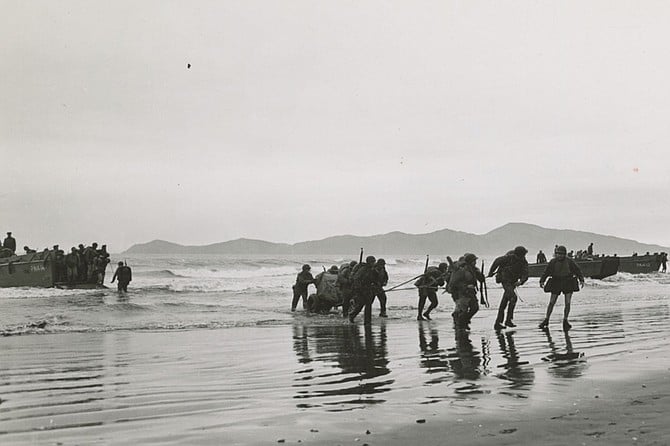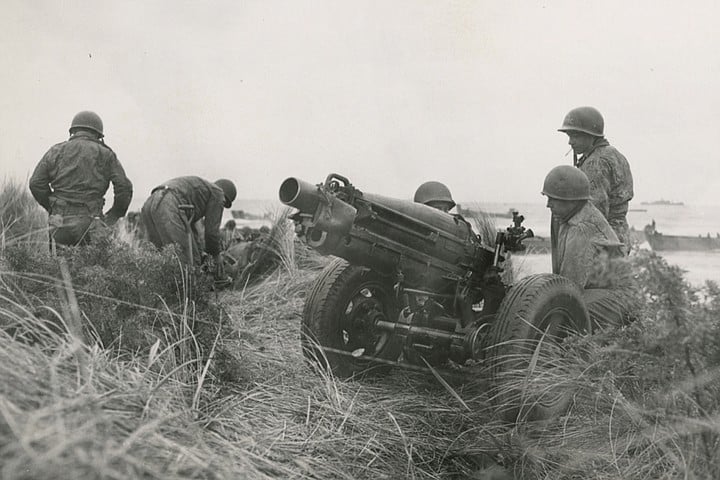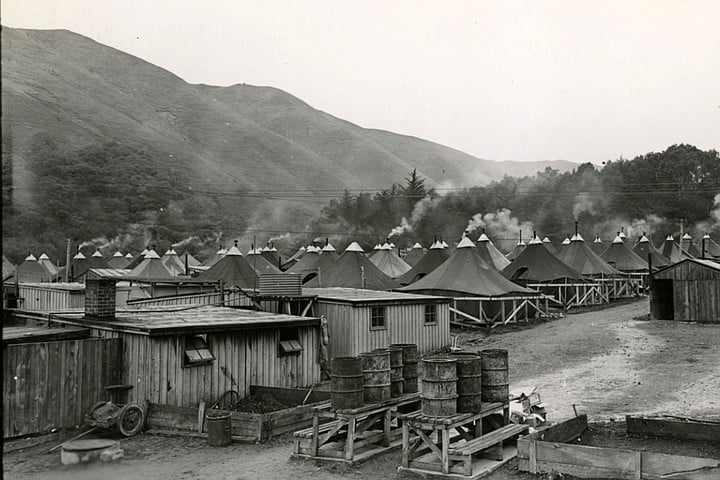 Facebook
Facebook
 X
X
 Instagram
Instagram
 TikTok
TikTok
 Youtube
Youtube

Waves crash on the edge of the Tasman Sea. Kapiti Island blocks a clean horizon that stretches to Australia. And the ghosts of 20,000 Camp Pendleton Marines who formed the “friendly invasion” of 1942 feel present.
This happened at Paekakariki, a beach community just north of New Zealand’s capital, Wellington. The past month has seen ceremonies marking this “friendly invasion,” when the first 5200 Marines came to practice amphibious landings under hostile fire. Every night on these beaches, real red tracer bullets would sear the sky. Landing crafts full of Marines would clang down their front flaps and disgorge men onto the beach in the face of mock enemy fire, fire that would become real soon enough. In six weeks, they would be heading for the Solomon Islands and the unfriendly invasion of Guadalcanal.

Locals had to get used to the landing craft crashing through the surf, the roar of Marines blasting their way through the shallows in full battle dress, the red tracer bullets zinging around them through the night sky, the artillery’s heavy thuds. And the danger was sometimes real: a landing craft was swamped by a large wave which stalled the engine. Nine bodies washed ashore. But the rough seas of the area didn’t discourage military planners. They kept troops training for the Pacific in Paekakariki from 1942-44.
“We were seen as a very good staging post for the Americans to launch the Pacific war, after the bombing of Pearl Harbor,” says Allie Webber, who is organizing the New Zealand side of an 80th anniversary get-together to commemorate those practice landings. “They could train down here. But we also offered, well, TLC. People loved having the Americans here. They opened up their hearts to them. They invited them home, they hosted them — in hospitals, and on their farms.”

And following after the young men, came the young local women. “Got any sisters, Sonny?” It’s a refrain Russell Price’s dad, Clive, would hear often those days, because girls were at a premium, and the GI’s were short on time, but not short on what was seen as their Hollywood charm, and cash to spend.
It wasn’t all harmony. “My grandma used to take to the Marines with her broom when they’d drive too close and mess up our fence with their tanks,” says Price. “Dad and his friends used to wait for them to go to lunch, and then clamber aboard the tanks while they were off in the mess hall. They were air-cooled Sherman tanks, and they’d often overheat. Dangerously. But it was just fun for Dad and his mates to play in the tanks while their crews were off for lunch.”
Not fun for the Marines, not when they shipped off to the Solomons and Guadalcanal. “This first lot were only here for six weeks, until they went off to Guadalcanal,” says Webber. “And then later on, the 2nd Marine Division came. They were here a lot longer, and connected with a lot more people. Their smoking tents filled most of one valley.” But even the 2nd Marine Division ended up leaving and going to the Battle of Tarawa, which was “a famous battle, a bloody battle.”

“And so many came back wounded,” says Webber. “Many went into our hospitals. If they had been in battle, when they came back, they were eligible for something like 90 days’ leave. So a lot of Marines traveled around New Zealand, and New Zealand families were offering to have them stay on their farms.”
Webber says far fewer veterans are coming to celebrate this year. “It’s the old story of people getting older, but they have a website which we’re doing up as a part of this 80th year to tell better stories.” And they are getting more business on the genealogy front. “A greater number are trying to track down their genealogy, women who married Marines and went over to America at the time. And the greater number includes those women who got pregnant and had the babies of American Marines. So I get quite a few inquiries like, ‘I’m trying to trace my grandmother,’ or, ‘I think my father was a Marine. His name was Mac, and he had beautiful green eyes, and Grandma loved him…’ Not very helpful when you’re trying to find a record of a real presence. But these are real lives, so we try to help.”
Maybe the most valuable contribution to this year’s celebrations is a gift: old and never-before-seen films, 30 of them, plus 800 stills featuring pictures from famed photographer Norm Hatch. They include shots taken from the camps, and from the actual battles at Guadalcanal. “This is invaluable contemporary information,” says Webber. “This is important.” And what films! “The Marines came, they trained, went off to war, they lost 1000 men at the battle for Tarawa [the Japanese lost 4000], then some of them came back here, to a very Kiwi kind of R&R,” says Webber.
But sometimes, it’s just personal. Webber says she recently met one of the high-ups from Camp Pendleton. “He was on an exercise down here, and he read in the newspaper that we were hosting six or eight veterans from the 2nd Marine. He thought that was amazing, and he realized that none of his Marines had ever met a veteran. And so he put them all into a minibus and brought them down here. And we had this very lovely little meeting in the park. These older veterans are just beautiful guys, meeting these young dudes. It was quite moving, actually.”


Waves crash on the edge of the Tasman Sea. Kapiti Island blocks a clean horizon that stretches to Australia. And the ghosts of 20,000 Camp Pendleton Marines who formed the “friendly invasion” of 1942 feel present.
This happened at Paekakariki, a beach community just north of New Zealand’s capital, Wellington. The past month has seen ceremonies marking this “friendly invasion,” when the first 5200 Marines came to practice amphibious landings under hostile fire. Every night on these beaches, real red tracer bullets would sear the sky. Landing crafts full of Marines would clang down their front flaps and disgorge men onto the beach in the face of mock enemy fire, fire that would become real soon enough. In six weeks, they would be heading for the Solomon Islands and the unfriendly invasion of Guadalcanal.

Locals had to get used to the landing craft crashing through the surf, the roar of Marines blasting their way through the shallows in full battle dress, the red tracer bullets zinging around them through the night sky, the artillery’s heavy thuds. And the danger was sometimes real: a landing craft was swamped by a large wave which stalled the engine. Nine bodies washed ashore. But the rough seas of the area didn’t discourage military planners. They kept troops training for the Pacific in Paekakariki from 1942-44.
“We were seen as a very good staging post for the Americans to launch the Pacific war, after the bombing of Pearl Harbor,” says Allie Webber, who is organizing the New Zealand side of an 80th anniversary get-together to commemorate those practice landings. “They could train down here. But we also offered, well, TLC. People loved having the Americans here. They opened up their hearts to them. They invited them home, they hosted them — in hospitals, and on their farms.”

And following after the young men, came the young local women. “Got any sisters, Sonny?” It’s a refrain Russell Price’s dad, Clive, would hear often those days, because girls were at a premium, and the GI’s were short on time, but not short on what was seen as their Hollywood charm, and cash to spend.
It wasn’t all harmony. “My grandma used to take to the Marines with her broom when they’d drive too close and mess up our fence with their tanks,” says Price. “Dad and his friends used to wait for them to go to lunch, and then clamber aboard the tanks while they were off in the mess hall. They were air-cooled Sherman tanks, and they’d often overheat. Dangerously. But it was just fun for Dad and his mates to play in the tanks while their crews were off for lunch.”
Not fun for the Marines, not when they shipped off to the Solomons and Guadalcanal. “This first lot were only here for six weeks, until they went off to Guadalcanal,” says Webber. “And then later on, the 2nd Marine Division came. They were here a lot longer, and connected with a lot more people. Their smoking tents filled most of one valley.” But even the 2nd Marine Division ended up leaving and going to the Battle of Tarawa, which was “a famous battle, a bloody battle.”

“And so many came back wounded,” says Webber. “Many went into our hospitals. If they had been in battle, when they came back, they were eligible for something like 90 days’ leave. So a lot of Marines traveled around New Zealand, and New Zealand families were offering to have them stay on their farms.”
Webber says far fewer veterans are coming to celebrate this year. “It’s the old story of people getting older, but they have a website which we’re doing up as a part of this 80th year to tell better stories.” And they are getting more business on the genealogy front. “A greater number are trying to track down their genealogy, women who married Marines and went over to America at the time. And the greater number includes those women who got pregnant and had the babies of American Marines. So I get quite a few inquiries like, ‘I’m trying to trace my grandmother,’ or, ‘I think my father was a Marine. His name was Mac, and he had beautiful green eyes, and Grandma loved him…’ Not very helpful when you’re trying to find a record of a real presence. But these are real lives, so we try to help.”
Maybe the most valuable contribution to this year’s celebrations is a gift: old and never-before-seen films, 30 of them, plus 800 stills featuring pictures from famed photographer Norm Hatch. They include shots taken from the camps, and from the actual battles at Guadalcanal. “This is invaluable contemporary information,” says Webber. “This is important.” And what films! “The Marines came, they trained, went off to war, they lost 1000 men at the battle for Tarawa [the Japanese lost 4000], then some of them came back here, to a very Kiwi kind of R&R,” says Webber.
But sometimes, it’s just personal. Webber says she recently met one of the high-ups from Camp Pendleton. “He was on an exercise down here, and he read in the newspaper that we were hosting six or eight veterans from the 2nd Marine. He thought that was amazing, and he realized that none of his Marines had ever met a veteran. And so he put them all into a minibus and brought them down here. And we had this very lovely little meeting in the park. These older veterans are just beautiful guys, meeting these young dudes. It was quite moving, actually.”
Comments